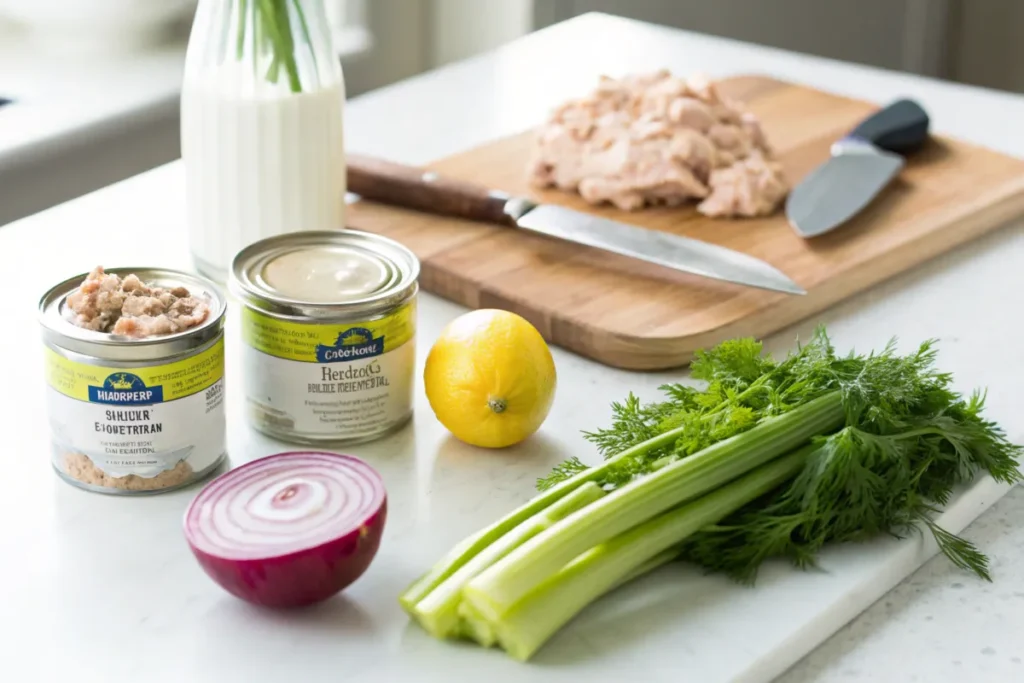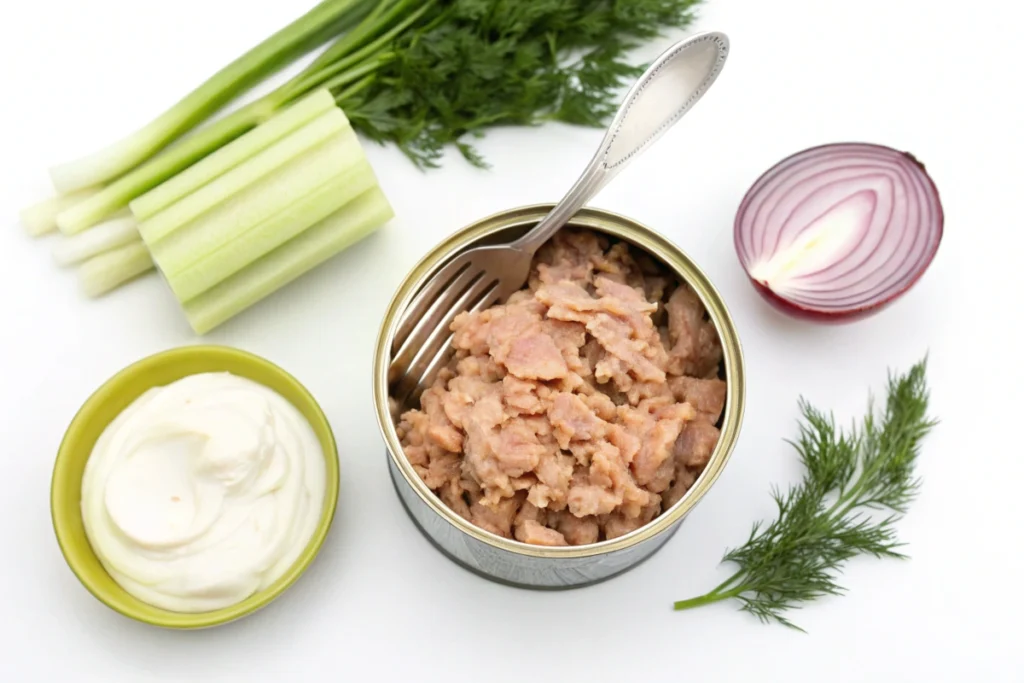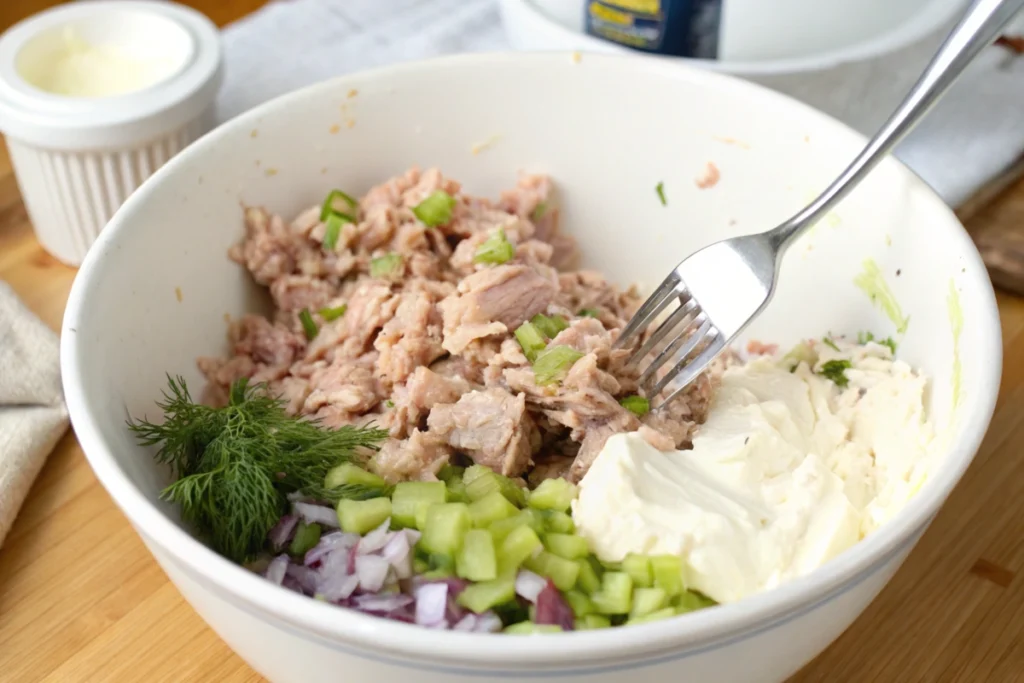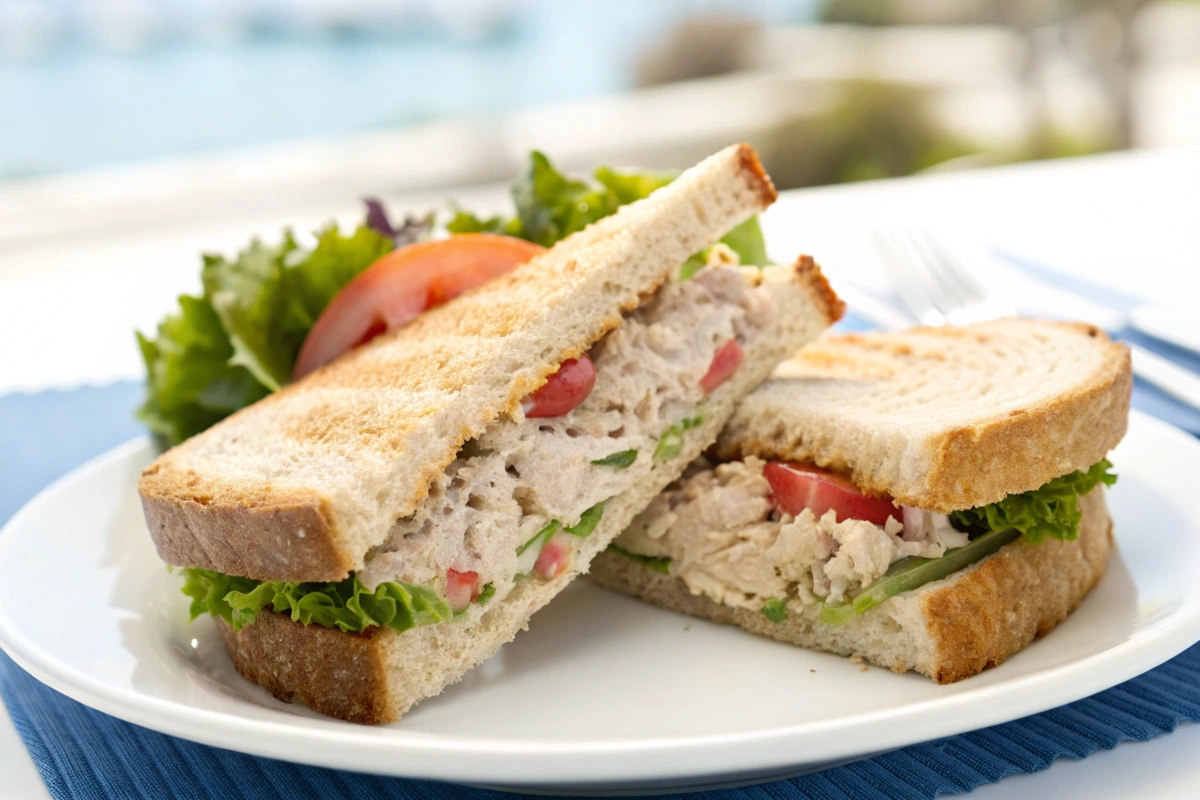How Long is Tuna Salad Good For?
How long is tuna salad good for? This is a common question for anyone who enjoys this classic dish. Knowing the answer is important for both food safety and ensuring you enjoy your tuna salad at its best. Tuna salad, a delightful mix of tuna, mayonnaise, and often other ingredients, is a popular choice for sandwiches and light meals. However, like many prepared foods, it has a limited shelf life. Therefore, understanding how long tuna salad remains safe and palatable is essential.
The Importance of Proper Storage
To begin with, the longevity of tuna salad largely depends on how it’s stored. Proper storage prevents the growth of harmful bacteria. Additionally, it helps maintain the quality and flavor of the salad. As a result, following recommended storage guidelines is crucial. Therefore, always refrigerate tuna salad promptly. Moreover, use airtight containers to minimize exposure to air and other contaminants.
Factors Affecting Tuna Salad’s Shelf Life
Several things affect how long tuna salad stays fresh. First, the freshness of the ingredients is important. For example, using fresh tuna instead of canned can make a difference. The quality of the mayonnaise and other mix-ins also counts. Moreover, the temperature at which you keep the tuna salad is essential. So, keeping a steady refrigerator temperature is important.

Essential Ingredients for Delicious Tuna Salad
Let’s start by looking at the main parts of a classic tuna salad. It’s important to know how each ingredient contributes to a tasty and balanced dish. The key to a great tuna salad is using high-quality core ingredients.
The Core Components: Tuna and Mayonnaise
In addition to choosing the right tuna, selecting the appropriate mayonnaise is crucial. For instance, different types of mayonnaise, such as regular, light, or even Greek yogurt-based versions, can significantly impact the overall flavor and texture of your tuna salad. Furthermore, the amount of mayonnaise you use can also be adjusted to your preference. Specifically, some people prefer a creamier tuna salad while others prefer a chunkier consistency.
Moreover, the type of tuna you choose plays a pivotal role in the final outcome. For example, you can opt for canned tuna packed in water or oil. Additionally, albacore tuna generally has a milder flavor compared to skipjack. Furthermore, consider using sustainably sourced tuna for an environmentally conscious choice. Specifically, look for certifications that indicate responsible fishing practices.
Adding Flavor and Texture: Vegetables and Seasonings
Beyond these basics, incorporating vegetables adds both flavor and texture to your tuna salad. To start with, celery is a classic addition that provides a refreshing crunch. In addition to celery, red onion adds a sharp bite that complements the richness of the tuna and mayonnaise. For instance, finely dicing the red onion helps to distribute its flavor evenly throughout the salad.
Furthermore, fresh herbs like dill brighten the flavor profile with their aromatic notes. Additionally, seasonings like salt and pepper are essential for enhancing the overall taste. For example, freshly ground black pepper adds a subtle heat and complexity. Moreover, a squeeze of lemon juice provides a touch of acidity that balances the richness of the mayonnaise.
Optional Enhancements: Fruits and Nuts
Beyond the traditional ingredients, you can explore optional additions to customize your tuna salad. Specifically, incorporating fruits like chopped apples or grapes introduces a sweet and tangy element. Equally important, the textural contrast of crunchy nuts like walnuts or pecans can elevate your tuna salad to another level. For instance, toasted walnuts add a nutty aroma and satisfying crunch.
Furthermore, consider adding hard-boiled eggs for extra protein and a creamy texture. Additionally, ingredients like chopped pickles or relish introduce a tangy and savory dimension. For example, sweet pickle relish adds a touch of sweetness while dill pickle relish provides a more pronounced sour flavor. Moreover, you can experiment with different spice blends to add a kick to your tuna salad.
Table: Ingredients for Tuna Salad:
| Ingredient | Quantity | Notes |
| Canned Tuna | 2 (5 ounce) cans | Drained |
| Mayonnaise | 1/2 cup | Use your preferred type (regular, light, etc.) |
| Celery | 1/2 cup | Finely chopped |
| Red Onion | 1/4 cup | Finely chopped |
| Fresh Dill | 1 tablespoon | Chopped (or 1 teaspoon dried dill) |
| Lemon Juice | 1 tablespoon | Freshly squeezed |
| Salt | 1/2 teaspoon | Or to taste |
| Black Pepper | 1/4 teaspoon | Freshly ground, or to taste |
Okay, let’s add more detail to the Preparation section to reach the 800-word target.
Preparing Your Tuna Salad: A Step-by-Step Guide
Before you begin, ensure your workspace is clean and sanitized. Firstly, this crucial step helps prevent bacterial contamination and ensures food safety. Next, gather all your ingredients and tools. After that, double-check the “best-by” date on the tuna cans to ensure maximum freshness. Subsequently, having everything organized will make the preparation process smoother and more enjoyable. Finally, a well-prepared mise en place is the key to culinary success.

Gathering Your Ingredients and Tools
Firstly, open your pantry and retrieve the canned tuna. Next, select your preferred type of mayonnaise from the refrigerator. After that, locate the fresh produce: celery and red onion. Subsequently, gather the fresh dill, lemon, salt, and pepper from your spice rack or refrigerator. Now that you have all the ingredients assembled, let’s move on to the tools. Firstly, you’ll need a sturdy can opener to open the tuna cans safely. Next, a sharp knife and a durable cutting board are essential for chopping the vegetables. After that, measuring cups and spoons will ensure accurate proportions of the ingredients. Subsequently, a large mixing bowl will provide ample space for combining all the components. Finally, a fork will be used for flaking the tuna and mixing the salad.
Draining and Flaking the Tuna
Firstly, position the tuna can on a stable surface. Next, carefully pierce the top of the can with the can opener. After that, rotate the can opener around the lid to create a clean opening. Subsequently, lift the lid, ensuring no sharp edges remain. Now that the can is open, carefully drain the liquid from the tuna. Firstly, tilt the can over the sink, allowing the liquid to flow out. Next, gently press the tuna against the side of the can to remove excess liquid. After that, transfer the drained tuna to the mixing bowl. Subsequently, use a fork to break apart the tuna into smaller pieces. Now that the tuna is flaked, you’re ready to proceed with the next step.
“For a smoother tuna salad, use a fork to flake the tuna into smaller pieces. For a chunkier texture, use larger flakes.”
Combining the Ingredients
Firstly, rinse the celery and red onion under cold water and pat them dry. Chop the celery into small pieces and finely dice the red onion. Measure the mayonnaise using a cup, leveling it off. Add the mayonnaise to the mixing bowl with flaked tuna, along with chopped dill, lemon juice, salt, and pepper. Gently combine all ingredients with a fork until mixed. Taste and adjust seasoning if necessary, adding more lemon juice for tang, salt for saltiness, or black pepper for heat.
Chilling and Serving
First, once the tuna salad is well mixed, transfer it to a clean, airtight container. Next, seal the container with a lid or plastic wrap. Then, place the container in the refrigerator. Allow the tuna salad to chill for at least one hour. Now that it’s chilled, the flavors will blend nicely. Finally, it’s time to serve and enjoy! Meanwhile, prepare your favorite sides. First, consider serving the tuna salad on toasted bread or crackers. Next, lettuce cups make a light and low-carb choice. For a heartier meal, serve it with a fresh green salad. The options are endless! Remember, well-chilled tuna salad can last for several days in the refrigerator.
Cooking Your Tuna Salad to Perfection: Tips and Techniques
While tuna salad doesn’t require cooking in the traditional sense, there are several techniques that can elevate its flavor and texture. When assembling your tuna salad, consider these tips to create a truly delicious meal. At this stage, even small adjustments can make a big difference.
No-Cook Tuna Salad: Maximizing Flavor Without Heat
Firstly, using high quality canned tuna is paramount. Consequently, the flavor of the tuna significantly impacts the overall taste of the salad. Thus, opt for tuna packed in water or oil, depending on your preference. Additionally, consider using solid or chunk light tuna for a firmer texture. Meanwhile, for a milder flavor, albacore tuna is an excellent choice.
Specifically, allow the tuna salad to chill in the refrigerator for at least 30 minutes before serving. For this reason, chilling allows the flavors to meld together beautifully. Consequently, this enhances the overall taste experience. Thus, patience is key to a truly delicious tuna salad.
Elevating Your Tuna Salad: Toasting Bread and Other Components
“Toasting the bread for your tuna salad sandwich adds a delightful crunch and prevents the filling from making the bread soggy.”
Firstly, if you’re using bread for your tuna salad sandwich, toasting it is highly recommended. Consequently, this simple step adds a wonderful textural contrast to the creamy filling. Additionally, toasting helps prevent the bread from becoming soggy from the moisture in the tuna salad. At this stage, you can choose your preferred toasting method: in a toaster, oven, or even on a skillet.
Meanwhile, consider toasting other components as well. Alternatively, try toasting nuts before adding them to the tuna salad for enhanced flavor and crunch. Specifically, walnuts or pecans work particularly well in tuna salad. For this reason, their nutty flavor complements the other ingredients.
Incorporating Cooked Elements: Hard-Boiled Eggs and Other Options
Firstly, hard-boiled eggs are a classic addition to tuna salad, providing extra protein and a creamy texture. Consequently, to prepare hard-boiled eggs, gently place them in a saucepan and cover with cold water. Thus, bring the water to a rolling boil, then remove from heat and let the eggs sit covered for about 10 minutes. Additionally, immediately transfer the eggs to an ice bath to stop the cooking process.
Meanwhile, other cooked elements can also enhance your tuna salad. Alternatively, consider adding cooked and crumbled bacon for a smoky flavor. Specifically, cooked pasta, such as rotini or macaroni, can be added to create a heartier tuna salad pasta salad. For this reason, pasta salad is a great option for potlucks or picnics. Finally, remember to chill any cooked additions before incorporating them into the tuna salad to maintain food safety.

Creative Tuna Salad Variations: Beyond the Classic
Just like many versatile dishes, this classic lunchtime staple offers endless possibilities for customization. In contrast to the traditional recipe, try these exciting variations to introduce new and exciting flavors to your meals.
Mediterranean Tuna Salad
For a Mediterranean twist, incorporate ingredients like Kalamata olives, feta cheese, and sun-dried tomatoes. A drizzle of olive oil and a sprinkle of oregano can further enhance these flavors. Alternatively, use Greek yogurt instead of mayonnaise for a lighter, tangier option. Chopped cucumbers and fresh parsley will complement the other ingredients beautifully. This variation offers a refreshing and healthy take on the original.
Spicy Sriracha Tuna Salad
On the other hand, if you prefer a kick, try adding sriracha. Start with a small amount and gradually increase it to reach your desired spice level. A squeeze of lime juice balances the heat. Chopped cilantro and sesame seeds add an Asian-inspired flair. This spicy version is sure to wake up your taste buds.
Curry-Infused Tuna Salad
For a unique and flavorful experience, incorporate curry powder. Use a mild curry powder to start, adjusting the amount to your liking. This variation introduces warm, aromatic spices. Adding chopped apples and golden raisins provides a sweet and savory contrast to the curry. This recipe is a delicious adventure for your palate.
Serving Tuna Salad Creatively
Classic Combinations
For a simple approach, serve the mixture between two slices of your favorite bread. Also, toasted bread adds a satisfying crunch. Furthermore, try adding lettuce, tomato, and onion for a classic sandwich.
Beyond the Sandwich
In addition to sandwiches, this versatile dish can be enjoyed in many ways. Similarly, it can be served in lettuce cups for a lighter option. For pairing, consider crackers or pita bread for scooping.
Presentation Tips
To enhance presentation, garnish with a sprinkle of paprika or chopped fresh herbs. Also, a lemon wedge adds visual appeal and a burst of flavor. Furthermore, consider serving it in a hollowed-out tomato or avocado for a unique presentation.
Serving Suggestions:
| Serving Style | Description |
| Classic Sandwich | On your favorite bread with lettuce, tomato, and onion. |
| Lettuce Wraps | Served in crisp lettuce cups for a low-carb option. |
| Crackers or Pita Bread | As a dip or spread for a quick and easy snack or appetizer. |
| Stuffed Tomato/Avocado | For a visually appealing and flavorful presentation. |
Nutritional Breakdown of Tuna Salad
This section provides a detailed analysis of the nutritional content found in a typical serving. Understanding this information can help you make informed choices about incorporating it into a balanced diet.
Macronutrients: Protein, Fat, and Carbohydrates
It’s important to note that this dish is a good source of protein, essential for building and repairing tissues. Furthermore, it contains a moderate amount of fat. Specifically, the fat content can vary depending on the type of mayonnaise and tuna used. For those watching their fat intake, opt for tuna packed in water and light mayonnaise.
“Opt for tuna packed in water instead of oil to reduce the overall fat content of your tuna salad.”
Vitamins and Minerals
This provides important vitamins and minerals in addition to macronutrients. It is especially rich in selenium, vitamin B12, and niacin. These nutrients are essential for many body functions. It also has smaller amounts of other vitamins and minerals.
Considerations for Dietary Needs
Ultimately, the nutritional content can be adjusted based on individual dietary needs. For those on a low-sodium diet, it’s important to choose low-sodium tuna and limit added salt. On the other hand, individuals looking to increase fiber intake can add ingredients like chopped celery or bell peppers. Consequently, customizing the recipe allows for a personalized nutritional profile.
Nutritional Information (per serving, based on a classic recipe):
| Nutrient | Amount per Serving | % Daily Value* |
| Calories | Approximately 250 | |
| Total Fat | Approximately 18g | 28% |
| Saturated Fat | Approximately 4g | 20% |
| Cholesterol | Approximately 40mg | 13% |
| Sodium | Approximately 400mg | 17% |
| Total Carbohydrate | Approximately 6g | 2% |
| Dietary Fiber | Approximately 1g | 4% |
| Total Sugars | Approximately 2g | |
| Protein | Approximately 20g | 40% |
*Percent Daily Values are based on a 2,000 calorie diet.
Enjoy Delicious and Safe Tuna Salad Today!
Key Takeaways for Tuna Salad Success
In summary, this guide has covered essential aspects of preparing and enjoying tuna salad safely. To sum up, remember these key points: proper storage is crucial for preventing spoilage, fresh ingredients enhance the flavor, and creative variations abound. Ultimately, by following these guidelines, you can confidently enjoy this classic dish.
Why You Should Try Making Your Own
Finally, making your own tuna salad allows you to control the ingredients and customize the flavor to your liking. As a final point, consider the benefits: you can choose high-quality tuna, adjust the amount of mayonnaise, and add your favorite seasonings and mix-ins. For these reasons, homemade tuna salad often tastes fresher and more flavorful than store-bought versions. All in all, it’s a simple and rewarding culinary endeavor.
Don’t wait, give tuna salad a try and transform your cooking experience! Explore more delicious recipes on Quickly Tasty today!

